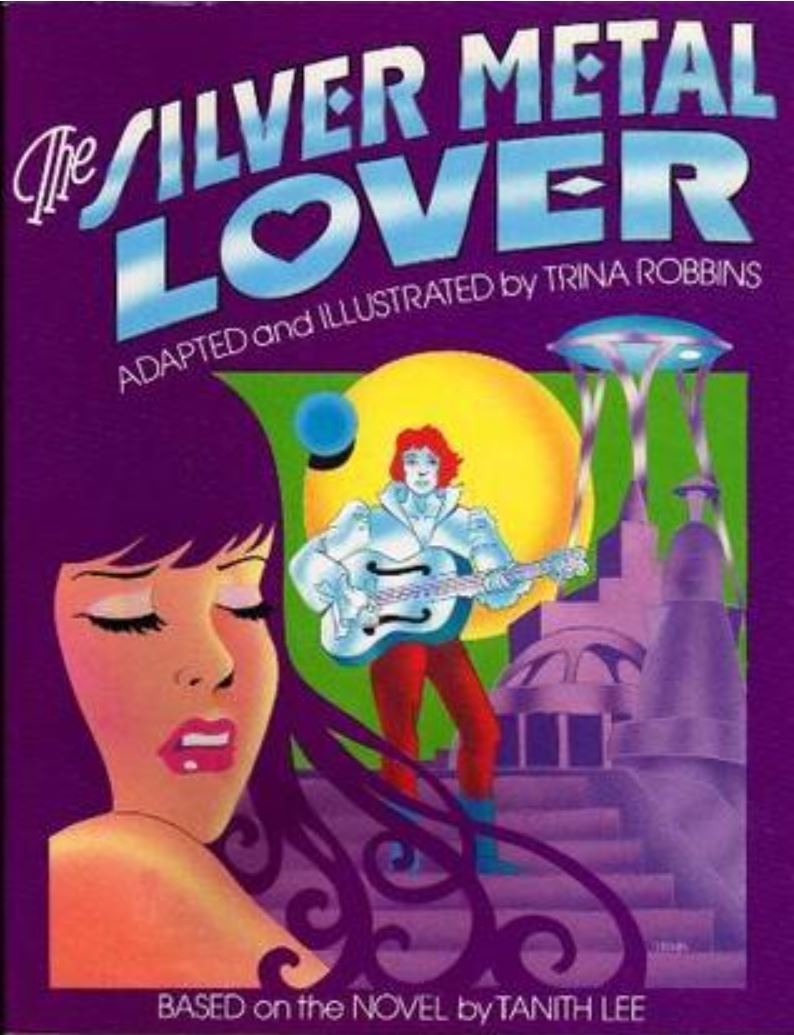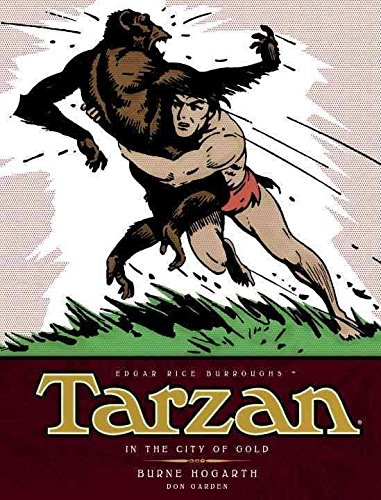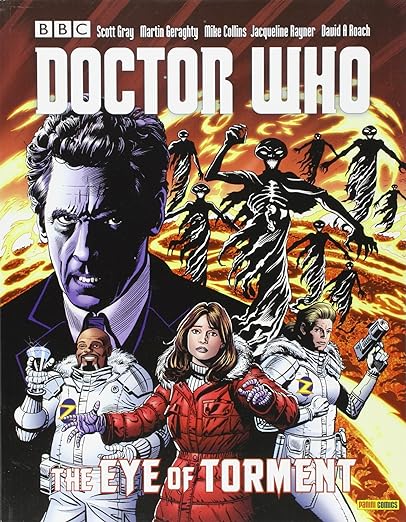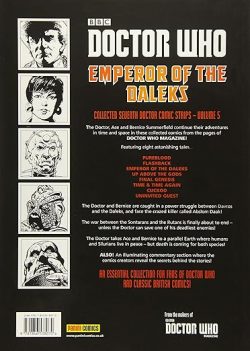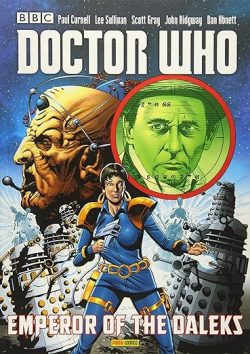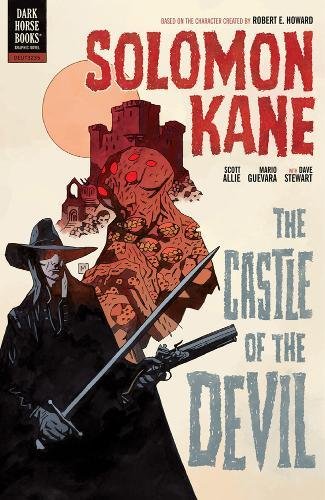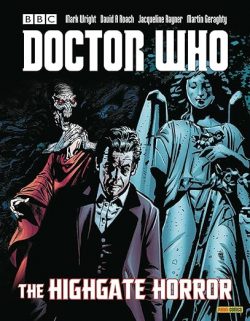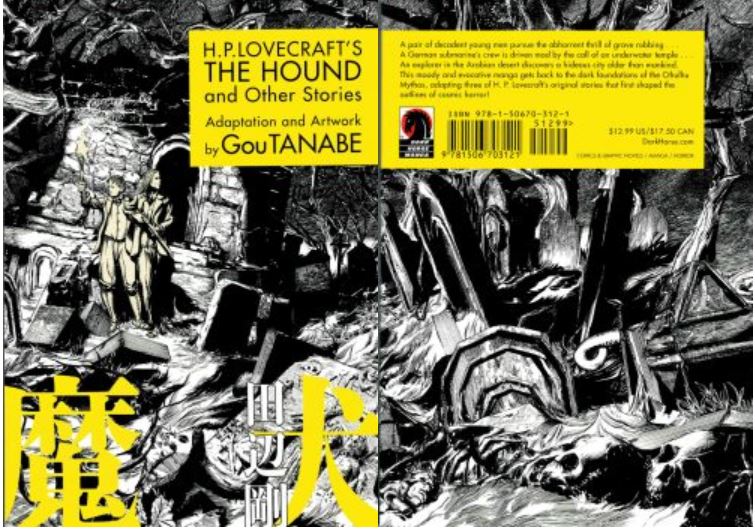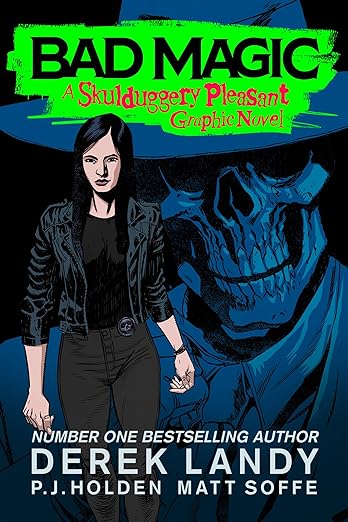
By Burne Hogarth & Rob Thompson with James Freeman, Dan Barry, Nick Cardy, Bob Lubbers & various (Titan Books)
ISBN: 978-1-78565-380-3 (landscape album HB)
This book includes Discriminatory Content produced during less enlightened times.
The 1930 and 1940s were decades of astounding pictorial periodical adventure. In the age before mass television, newspaper strips (and their bastard spawn comic books) were the only form of visually-based home entertainment for millions of citizens young and old, consequently shaping the culture of many nations. Relatively few strips attained nigh-universal approval and acclaim. The Gumps, Little Orphan Annie, Flash Gordon, Mandrake the Magician, Terry and the Pirates and Prince Valiant were in that rarefied pantheon but arguably the most famous was Tarzan.
Evolving from mock melodrama comedic features like Roy Crane’s Wash Tubbs or Carl Ed’s Harold Teen, the full-blown dramatic adventure serial truly started on January 7th 1929 with Buck Rogers and Tarzan debuting that day. Both were skilful adaptations of pre-existing prose properties and their influence changed the shape of the medium forever. The following years saw an explosion of similar fare, launched with astounding rapidity to huge success. Not only strips, but also actual fictive genres were born in that decade, still impacting today’s comic books and all our popular entertainment forms.
In terms of art quality, adaptations of Edgar Rice Burroughs’ immensely successful novels starring jungle-bred John Clayton, Lord Greystoke by Canadian commercial artist Harold “Hal” Foster were unsurpassed. The strip soon became beloved by the masses, supplementing and nurtured by the movies, books, radio show and ubiquitous advertising appearances.
As detailed in previous volumes of this sublime oversized (330 x 254 mm), monochrome/full -colour hardback series, Foster initially quit at the end of a 10-week adaptation of first novel Tarzan of the Apes. He was replaced by Rex Maxon, but at the insistent urging of author Burroughs, returned when the black-&-white daily expanded to include a lush, full colour Sunday page offering original adventures. Maxon was left to capably handle the weekday book adaptations, as Foster crafted the epic and lavish Sunday page until 1936: 233 consecutive weeks. He then left again for good: moving to King Features Syndicate and his own landmark weekend masterpiece Prince Valiant in the Days of King Arthur which debuted in February 1937. Once the 4-month backlog of material he had built up was gone, Foster was succeeded by a precociously brilliant 25-year old neophyte.
Burne Hogarth was a passionate graphic visionary whose superb anatomical skill, cinematic design flair and compelling page composition revolutionised action/adventure narrative illustration. His galvanic dynamism of idealised human figures and animals can still be seen in today’s comic books: all that impossibly body-positive perfection in motion can be directly attributed to Hogarth’s pioneering drawing and, in later years, educational efforts. Burroughs was a big fan and cannily used the increasingly popular comic strip to cross-market his own prose efforts with great effect.
This fabulous fifth & final tome encompasses Sunday pages from October 1949 to September 1950 and the equivalent Daily strips (September 1947 through September 1950), with Hogarth gradually easing out of the now-onerous job and employing a legion of gifted ghosts to fulfil his obligations. During this period, commercially-led format changes reduced the size and changed the shape of the Sunday strip from tabloid to landscape framing, but the contents suffered no loss of wonder, action or drama. The transition and repercussions are discussed with some academic frontloading and fitting further explanation in the form of extended essay ‘Transforming Tarzan’s Jungle’ by Henry G. Franke III. Fully briefed for our trek, we resume the fun with ‘Tarzan and the Adventurers’: Sunday pages #973 – 1010 as seen spanning October 30th 1949 to July 16th 1950. The saga was crafted by Hogarth, writer Rob Thompson and latterly James Freeman – who was forced upon Hogarth after the syndicate fired his preferred collaborator. It sees the Ape-Man visiting old ally Masai chief N’Kola just as white explorers Baker and Cleveland arrive, seeking the tribes’ help in locating a medicinal herb which might be a malaria cure.
In truth, the scurrilous duo are hunting lost treasure sunk in kingdom-demarcating Lake Dagomba, and need help in convincing Dagomba headman Mabuli to allow them access. This chief hates Tarzan but the impasse is ended when wicked witch doctor Chaka strikes a sinister side deal that triggers valiant efforts and vile betrayal, double cross, murder and bloody civil warfare incorporating spectacular chases, fantastic duels with beasts, mortals and the very landscape, captivating readers for months until the saga ended with explosive irony and tons of TNT…
The end was near for Hogarth and the Jungle Lord, and the Sunday association closed in a short serial finished by a comic book artist slowly making strips his career. Born in 1922, Robert Bartow “Bob” Lubbers drew a host of features before WWII, but other than The Vigilante and The Human Fly after hostilities ceased, mostly settled on newspaper stars like The Saint, Big Ben Bolt, Li’l Abner, Secret Agent X-9 and his own creations Long Sam and Robin Malone. That all occurred after a stellar run assisting/replacing Hogarth.
Ostensibly crafted by – and still signed “Hogarth”, ‘Tarzan and the Wild Game Hunters’ (#1011-1019: July 23rd to September 17th 1950) saw the vine-voyaging valiant aid cowboy-turned safari man Russ Rawson in capturing a rhino and gorilla for Winchester Zoo… but only after determining that Africa would be a far better place without these pair of particularly perilous rogue beasts…
Before switching to moody monochrome and standard single tier-per-diem layouts for the dailies section, Franke III explores ‘The Daily Grind’ in another erudite prose prologue preceding the accumulated serial sequences: providing context and background on writer Thompson and artistic aids/replacements Dan Barry, Nick Cardy & Lubbers, with John Lehti and Paul Reinman also getting a worthy mention.
Monday to Saturday storylines were relentless and tough to get right. No matter how good you are, there’s only so much progress to be made in 3-4 panels at a time, and savvy creators usually combined classic themes with familiar material whenever they could. Here that notion resulted in a (very) broad adaptation/reinterpretation of ERB’s prose pulp serial Tarzan at the Earth’s Core, which had been first serialised between September 1929 and March 1930 ,before becoming the 13th canonical novel in 1932. The strips comprising ‘Tarzan at the Earth’s Core’ (#2509 to 2616, September 1st 1947 through January 3rd 1948) were supervised by Hogarth & Thompson but limned primarily by Dan Barry (1911-1997).
He also began as a jobbing comic book guy. Like his own brother Seymour “Sy” Barry – who produced The Phantom newspaper strip for three decades – Dan worked in a finely-detailed, broadly realistic style, blending aesthetic sensibility with straightforward visual clarity and firm, almost burly virile toughness: a gritty “He-man” attitude for a new era, contemporarily christened “New York Slick”.
He drew masked hero fare like Airboy, Skywolf, Boy King, Black Owl, Spy Smasher, Doc Savage and more before joining the US Air Force and, on returning after the hostilities, drew monster hero The Heap and sundry genre shorts for titles like Crimebusters whilst running his own outfit producing educational/informational comics. Dan began his gradual withdrawal from funnybooks as early as 1947, joining Hogarth’s studio and assuming art chores on the Tarzan daily for a year, whilst still gracing DC’s crime, mystery and science fiction anthologies until as late as 1954. He was offered Flash Gordon and quickly accepted, but that’s the stuff of another review…
In deepest, darkest Africa, the Jungle Lord is tracked down by explorer Jason Gridley who has been in contact with a man named David Innes, and resolved to save that lost soul. Innes is an adventurer who joined Professor Abner Perry in a giant drilling vehicle that took them deep inside the Earth. They are now trapped in an incredible antediluvian realm more than 500 miles below the world’s crust: a land of beast men, lost empires, dinosaurs and even more incredible things…
Tarzan is largely a spectator for this sequence as ERB’s prose adventures in Pellucidar are updated and recounted for readers before Lord Greystoke joins the rescue party using another mole machine – built by boffin Dr. Dana Franklin – to reach the exotic underworld. Adding romantic interest is Franklin’s glamourous daughter/assistant Doris as they voyage deep into a myriad of incredible adventures.
As well as saving Innes and Perry and reuniting the former with his own true love Dian the Beautiful, the newcomers face sentient pterodactyl tyrants (Thipdars if you’re au fait with the books), clash with cavemen and ape beasts (Sagoths), fight a macabre menagerie of long-extinct monsters, war with lizard warriors (Horibs) and get utterly lost and reunited in a land where time does not pass and night never comes…
The series is a paean to primitivism and is a boost to all those besotted with wild kingdoms. There are even pulchritudinous primeval pairings… Gridley to cavegirl princess Jana and Doris with Clovian cave chief Ulan…
The drama is divided into individual overlapping adventures until all the players eventually reunite for a big, big finale. With the aforementioned ghost artists deployed to augment Barry & Thompson, the saga concludes with episodes #2617-2640 of ‘Tarzan at the Earth’s Core’ (January 5th – 31st January 1948) as all the plot threads cleave together and those who want to return to the surface do so…
Although he was still involved in a mostly administrative capacity, Hogarth’s signature had been missing for some time when ‘Tarzan and Hard-Luck Harrigan’ #3361-3414: 22nd May – 22nd July 1950) began. The strip sported the name of new illustrator Nick Cardy; AKA strip veteran Nicolas Viscardi, who had drawn Lady Luck and other features for Will Eisner, and post-war became a DC mainstay on Gang Busters, Congo Bill, Aquaman, Teen Titans, Bat Lash, Batman/The Brave and the Bold and so much more. The tale itself was lighter fare with humorous overtones as Greystoke encountered a decrepit and devious old western prospector/snake oil peddler who had foolishly hitched his wagon to an African adventure… The affable scoundrel initially tried to capture Tarzan’s monkey pals before attempting to catch and sell the Ape-man himself before learning the error of his ways…
Sadly, old habits died hard. When the odd companions encountered desert raider El Mahmud dying of wounds, they were forced by the bandit’s devoted lieutenant Rambul to “cure” him with Harrigan’s bottled nostrum. That’s when the literal gold-digger spots the treasure the raiders possess and reverts to type, determined to enjoy one last lucky strike, no matter who he must betray…
Again demarcated by an artist change, ‘Tarzan and Hard-Luck Harrigan’ concluded with episodes #3415-3420 (24th – 29th July 1950) signifying the beginning of Lubbers 3½ year tenure, with a rowdily raucous big battle and the old coot’s redemption before moving briefly on to final inclusion ‘Attack of the Apes’ (#3421-3462: 31st July – 16th September 1950) with Lubbers benefitting from Hogarth’s last moments of oversight in a spooky yarn where a renegade troop of Great Apes (the fictious subspecies that reared Tarzan) begin attacking native villages…
After investigating in the primal manner of the lord of the forests, Tarzan gains a new anthropoid assistant in brutal Bay-At, learns who, why and what the true culprits are and renders his own judgement…
And that was that for Hogarth’s Tarzan until a flurry of new material appeared as graphic novel prototypes in the 1970s, which helped usher in a more mature view of the comics medium itself.
Tarzan is a fictive figure who has attained immortal reality in a number of different creative arenas, but none offer the breathtaking visceral immediacy of Burne Hogarth’s comic strips. These vivid visual masterworks are all coiled-spring tension or vital, violent explosive motion: stretching, running, fighting, surging rushes of power and glory where even backgrounds and landscapes achieve a degree of dramatic interactive expressionism. It’s a dream come true that these majestic exploits are available in full for ours and future generations of dedicated fantasists to enjoy.
Trademarks Tarzan® and Edgar Rice Burroughs® owned by Edgar Rice Burroughs, Inc. and Used by Permission. Copyright © 2018 Edgar Rice Burroughs, Inc. All Rights Reserved.




